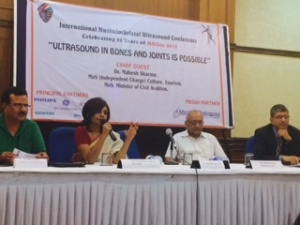07 September, 2015
It quite often happens that in the event of a pathology of bones and joints, basic investigation of X-ray does not detect any injury and due to multiple reasons, a conclusive diagnosis is not reached… In certain types of injuries, especially in children and elderly with very osteoporotic bones X-rays fail to identify fractures , which leaves both the patient and doctor perplexed. In these situations, a doctor has to rely on higher modalities of CT and MRI which are not only expensive for the patient but at many a times, uncomfortable , hazardous in case of certain cardiac produces having been done and in case of children relatively detrimental to growing young bones. High frequency Ultrasound has come as a boon for such and many other conditions in evaluation of bones and joints. It has proven to be quite effective in giving a diagnosis and facilitating treatment especially in emergency situations.
Musculoskeletal Ultrasound Society (MUS) organized a press conference to update the media and the public about the rising popularity of this modality called Musculoskeletal Ultrasound (MSUS) , which is quite firmly established in the West, and is now slowly gaining roots in India as well. With the same machines but Higher frequency ( 5 MHz- 18 MHz) Linear probes, radiologists can now perform the ultrasound of bones, joints and muscles to identify fractures, ligament tears, bending of bones (common in children). This is specially useful in those patients who are claustrophobic and do not want to get into the gantry of CT or MRI machine , as well as in those who cannot be prescribed MRI due to presence of pacemakers, implants, etc.
Speaking at the conference, was its organiser Dr Nidhi Bhatnagar, MSUS Specialist Radiologist at Sanjeevan Hospital and Secretary, MUS who said “Musculoskeletal Ultrasound addresses two major issues in diagnostics today, cost-effectiveness and Ease of availability. It is a very effective complimentary dynamic multi-planar modality to other existing cross-sectional modalities and has its firm advantages and applications in the evaluation of MSK pathologies. If an Ultrasonologist is equipped and has the necessary know-how, he can easily perform a Musculoskeletal Ultrasound to give accurate diagnosis. The only pitfall is a steep learning curve and dearth of credible / accredited teaching programs which Muskuloskeletal Ultrasound Society is providing continually to help MSUS come of age in India too”
Dr Dhananjay Gupta, Sr Arthoscopic and Joint replacement surgeon and Secy Delhi Orthopedic association said, “ Many of my patients have got implants or prosthesis inside their body, which makes it difficult for them to have an MRI. Such problems also exist with cardiac patients with stents, pacemakers. Musculoskeletal Ultrasound ( a.k.a MSK USG) is the only alternative available for diagnosis in such patients. Moreover, children have soft bones, which don’t breakbut bend with an injury. This bend may not be appreciated on an MRI, but can beeasily diagnosed with an MSK USG with less time , money and effort .”
1 PTO.
In children, where CT , a radiation based modality and with an MRI we need to be given sedation, High frequency ultrasound of bones and joints is a much comfortable and easier alternative. Its also recommended for identifying tissue tumours, soft tissue injuries, in presence of foreign bodies especially non-metallic ones like wooden splinters, or thorns which may less easily appreciated with other modalities.
On the use of this modality Dr Sudhir Gupta, leading Radiologist , CEO Cygnus Group of Hospitals and President elect Delhi State IRIA said, “ This modality is and has been a routine investigative tool in the US, for past 20 years It is relatively a new concept in India, primarily due to lack of awareness not only amongst the patients but also amongst Medical community. Since the clinicians and orthopedicians thought of it as a myth, radiologists found themselves on a back foot too. To summarize, MSUS is an important investigation providing valuable information at much less a cost, being non-radiation dependent, has ease of operability and availability , gives quick results, can perform multiple simultaneous evaluations should need be in the same sitting, multiple reviews without fear of harmful effects, no sedations, no contraindications and above all a fantastic modality in emergency conditions.
Dr. Gothi is firmly of the opinion that Ultrasound should be a tool like an extended stethescope and the applications should be widely applied to all specialities . The maximum benefit is delivered only when a modality is not restricted and is utilized at every stage of learning .’
About Musculoskeletal Ultrasound Society (MUS)
MUS consists of group of professionals from the fields of Radiology, Orthopaedics, Rheumatology and Anaesthesia ( Pain Management), Sports Medicine from New Delhi who have a passion for furthering the application of Ultrasound in the diagnosis of MSK pathologies. Its under-utilization amongst clinicians propelled thoughts into creation of a Society by the name of Musculoskeletal Ultrasound Society (MUS) which as per our expectations has unfolded into a great teaching and learning Institution.
Our team comprises of Dr. R.K.Mathur, Senior Radiologist and Patron, MUS , Dr Rajesh Gothi, Chief Radiologist Saket city hospital, New Delhi, Lt. Gen. Dr. Ved Chaturvedi, Chief Rheumatologist, Ganga Ram Hospital, Dr. Anmol Maria, Senior Orthopedician and Joint replacement Surgeon, Dr Dhananjay Gupta, Secretary DOA and Senior Orthopedician, , Dr.Sanjay Thulkar (AIIMS , Ass. Prof Radiology), Dr. Pankaj Surange ( Consultant Pain Mgt, Anaesthesia), Dr.Sudhir Gupta (Senior Radilogist , CEO, Cygnus Gp, President Elect Delhi state IRIA) ,, Mr Anil Srivastava ( Senior Tech Advisor) , Dr. Manoj Sharma ( Senior Radiologist, Rockland Hospital.), Dr. Renu Dhingra ( Ass Prof., AIIMS, Anatomy).
